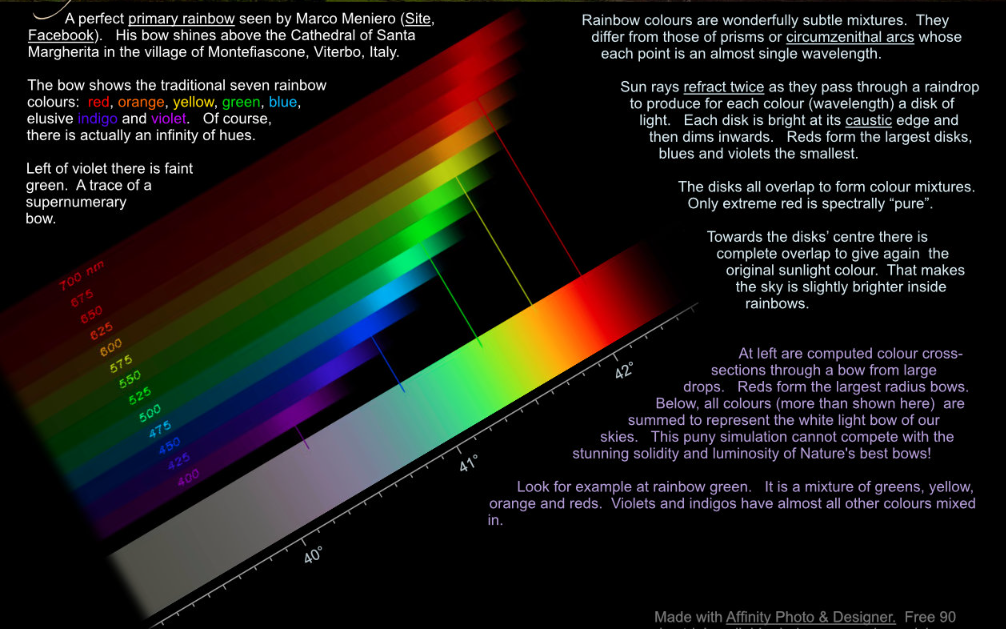A perfect rainbow
A Perfect Rainbow: An Enchanting Display of Colors in the Sky
Rainbows have captivated humans for centuries with their vibrant and mesmerizing display of colors. One such remarkable example is the perfect primary rainbow captured by Marco Meniero above the Cathedral of Santa Margherita in Montefiascone, Italy. This awe-inspiring phenomenon showcases the traditional seven rainbow colors: red, orange, yellow, green, blue, elusive indigo, and violet. However, it is important to note that there is actually an infinite range of hues present in a rainbow.
Beyond the violet hue, a faint trace of green can be observed, indicating the presence of a supernumerary bow. These additional bows occur due to the interference of light waves within the raindrops, resulting in multiple overlapping rainbows with slightly shifted colors.
The colors of a rainbow are not simple and uniform; rather, they are wonderfully subtle mixtures. Unlike the colors produced by prisms or circumzenithal arcs, which consist of almost single wavelengths, rainbow colors are composed of overlapping disks of light. Each disk corresponds to a specific color or wavelength and is brightest at its caustic edge, gradually diminishing towards its center. Reds create the largest disks, while blues and violets form the smallest ones.
As the disks overlap, they create beautiful mixtures of colors, with only extreme red appearing spectrally "pure." Towards the center of the disks, there is complete overlap, resulting in the reconstitution of the original sunlight color. This phenomenon causes the sky inside rainbows to appear slightly brighter than its surroundings.
To better understand the intricate details of a rainbow's composition, computed color cross-sections through a bow from large raindrops can be examined. These simulations reveal that reds form bows with the largest radii, while other colors are progressively smaller. When all the colors are summed together, they represent the white light bow that we commonly observe in our skies. However, it is important to note that no simulation can fully replicate the stunning solidity and luminosity of nature's best rainbows.
Let's take a closer look at some specific rainbow colors:
- Rainbow green: This color is a mixture of greens, yellows, oranges, and reds, blending together to create a vibrant and captivating shade.
- Violets and indigos: These colors contain almost all other colors mixed in, resulting in a rich and complex hue.
The enchanting beauty of a perfect rainbow serves as a reminder of the remarkable optical phenomena that occur in our atmosphere. While we may attempt to simulate and understand these phenomena through scientific methods, the true magnificence of nature's displays can only be fully appreciated when witnessed firsthand. So, the next time you find yourself under a clear sky after a rain shower, take a moment to gaze at the colorful arc above you and marvel at the wonders of atmospheric optics.


A perfect primary rainbow seen by Marco Meniero (Site, Facebook). His bow shines above the Cathedral of Santa Margherita in the village of Montefiascone, Viterbo, Italy.
The bow shows the traditional seven rainbow colours: red, orange, yellow, green, blue, elusive indigo and violet. Of course, there is actually an infinity of hues.
Left of violet there is faint green. A trace of a supernumerary bow.
Rainbow colours are wonderfully subtle mixtures. They differ from those of prisms or circumzenithal arcs whose each point is an almost single wavelength.
Sun rays refract twice as they pass through a raindrop to produce for each colour (wavelength) a disk of light. Each disk is bright at its caustic edge and then dims inwards. Reds form the largest disks, blues and violets the smallest.
The disks all overlap to form colour mixtures. Only extreme red is spectrally "pure".
Towards the disks' centre there is complete overlap to give again the original sunlight colour. That makes the sky is slightly brighter inside rainbows.
At left are computed colour cross- sections through a bow from large drops. Reds form the largest radius bows. Below, all colours (more than shown here) are summed to represent the white light bow of our skies. This puny simulation cannot compete with the stunning solidity and luminosity of Nature's best bows!
Look for example at rainbow green. It is a mixture of greens, yellow, orange and reds. Violets and indigos have almost all other colours mixed in.
Made with Affinity Photo & Designer. Free 90
Note: this article has been automatically converted from the old site and may not appear as intended. You can find the original article here.
Reference Atmospheric Optics
If you use any of the definitions, information, or data presented on Atmospheric Optics, please copy the link or reference below to properly credit us as the reference source. Thank you!
-
<a href="https://atoptics.co.uk/blog/a-perfect-rainbow/">A perfect rainbow </a>
-
"A perfect rainbow ". Atmospheric Optics. Accessed on October 21, 2024. https://atoptics.co.uk/blog/a-perfect-rainbow/.
-
"A perfect rainbow ". Atmospheric Optics, https://atoptics.co.uk/blog/a-perfect-rainbow/. Accessed 21 October, 2024
-
A perfect rainbow . Atmospheric Optics. Retrieved from https://atoptics.co.uk/blog/a-perfect-rainbow/.